#stem-mammal
Explore tagged Tumblr posts
Text

Angelosaurus dolani was an early synapsid, part of the caseid family and closely related to the more well-known Cotylorhynchus.
Living in what is now Texas, USA during the mid-Permian, about 270 million years ago, it's only known from partial skeletal remains but was probably around 3m long (~10').
Like other large herbivorous caseids it would have had a tiny head with proportionally big nostrils, a short neck, a large barrel-shaped body accommodating a voluminous gut, a long tail, and strong sprawling limbs. But compared to its relatives Angelosaurus was particularly bulky, with shorter thicker heavily-muscled limbs and stubbier digits ending in broad hoof-like claws.
In closely related caseids the presence of teeth on the roof of the mouth and a well-developed hyoid apparatus suggests these animals had big tough tongues, which may have been used to mash mouthfuls of plant matter against the palatal teeth to partially break it up before swallowing.
Based on skin impressions from other early synapsids, Angelosaurus probably had crocodilian-like scutes on some parts of its body – likely on its underside and tail, and maybe also on the top of the head as indicated by the pitted bone texture of caseid skulls – but whether the rest of its skin was scaly or naked and glandular is currently unknown.
In recent years there have also been some proposals that large caseids may have had a semiaquatic hippo-like ecology, but this idea is controversial.
———
NixIllustration.com | Tumblr | Patreon
References:
Olson, Everett C., and James R. Beerbower. "The San Angelo formation, Permian of Texas, and its vertebrates." The Journal of Geology 61.5 (1953): 389-423. https://doi.org/10.1086/626109
Reisz, Robert R., Diane Scott, and Sean P. Modesto. "Cranial anatomy of the caseid synapsid Cotylorhynchus romeri, a large terrestrial herbivore from the Lower Permian of Oklahoma, USA." Frontiers in Earth Science 10 (2022): 847560. https://doi.org/10.3389/feart.2022.847560
Romano, Marco, Neil Brocklehurst, and Jörg Fröbisch. "The postcranial skeleton of Ennatosaurus tecton (Synapsida, Caseidae)." Journal of Systematic Palaeontology 16.13 (2018): 1097-1122. https://doi.org/10.1080/14772019.2017.1367729
Werneburg, Ralf, et al. "A new caseid synapsid from the Permian (Guadalupian) of the Lodève basin (Occitanie, France)." Palaeovertebrata 45.2 (2022). http://dx.doi.org/10.18563/pv.45.2.e2
Wikipedia contributors. “Angelosaurus” Wikipedia, 30 Nov. 2024, https://en.wikipedia.org/wiki/Angelosaurus
Wikipedia contributors. “Caseidae” Wikipedia, 19 Dec. 2024, https://en.wikipedia.org/wiki/Caseidae
#science illustration#paleontology#paleoart#palaeoblr#angelosaurus#caseidae#caseasauria#synapsid#art#protomammal#stem-mammal#maximum chonk
249 notes
·
View notes
Text

Research alert! Two new fossils of a mouse-sized animal from the age of dinosaurs indicate that early mammals grew more slowly and lived longer than their modern descendants—rewriting our understanding of the lives of the very earliest mammals. An international study led by researchers at National Museums Scotland and published today in the journal Nature, compares two Krusatodon kirtlingtonensis fossils discovered decades apart in Scotland’s Isle of Skye. One of the fossils, the only juvenile Jurassic mammal skeleton known to science, was discovered in 2016 by Roger Benson, the Museum’s Macaulay Curator in the Division of Paleontology, and colleagues.
“These fossils are among the most complete mammals from this time period in the world,” said Elsa Panciroli, the lead author of the study and an associate researcher of paleobiology at National Museums Scotland.
Learn how these small animals give us unprecedented insights into the lives of early mammals.
Image: © Maija Karala
#science#amnh#museum#fossil#nature#natural history#animals#paleontology#fact of the day#did you know#new research#research#stem#mammal#mammals#evolutionary biology#ancient animals#paleobiology
623 notes
·
View notes
Text
If you were to host a blacklight party in the taxidermy wing of a natural history museum, most of the mammals would fit right in with their eerie fluorescent glow. That's what Kenny Travouillon, the curator of mammalogy at the Western Australian Museum, found when his team shone ultraviolet light on 125 species of mammal in the collection. The luminous effect wasn't restricted to platypuses and wombats, which were identified as biofluorescent species a few years ago. Every species of mammal they examined emitted a green, blue, pink, or white hue under UV light. The inside of a red fox's pointy ears turned shocking, fluorescent green. The polar bear lit up like a white t-shirt under a blacklight, as did the zebra's white stripes and the leopard's yellow fur. The wings of the orange leaf-nosed bat became a stark white skeleton, while its fur glowed pink. And the ears and tail of the greater bilby shone "bright like a diamond," as Travouillon described in 2020. The study showed that fluorescence is present in half of mammalian families, almost all clades, and in all 27 orders.
Continue Reading
2K notes
·
View notes
Text


Result from the Tiaojishan formation #paleostream! We had a closer look at the arboreal fauna of this formation
Also some close ups
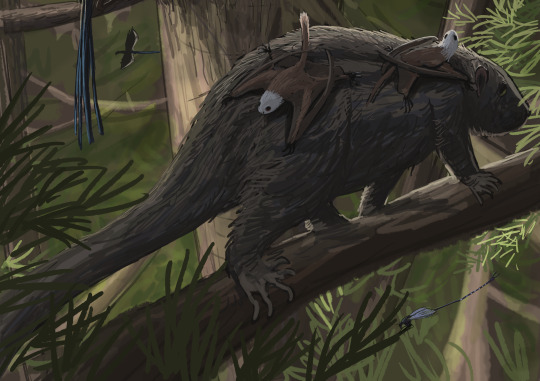
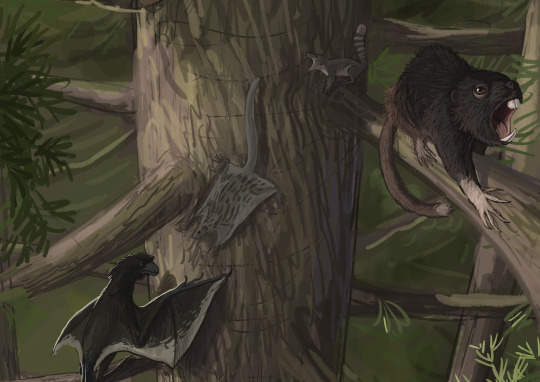

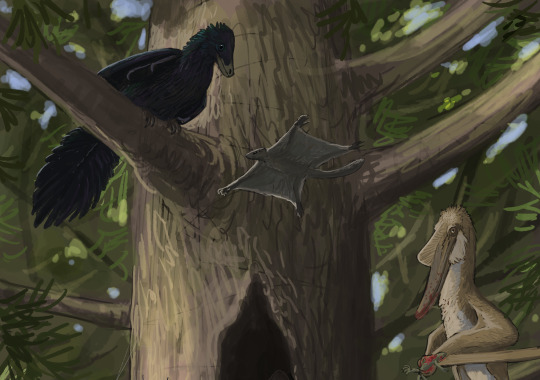
#sciart#paleoart#paleostream#palaeoblr#dinosaur#jurassic#pterosaur#caihong#anurognathids#stem birds#mammals#gliding bois#arboreal#jurassic forest#tiaojishan
861 notes
·
View notes
Text
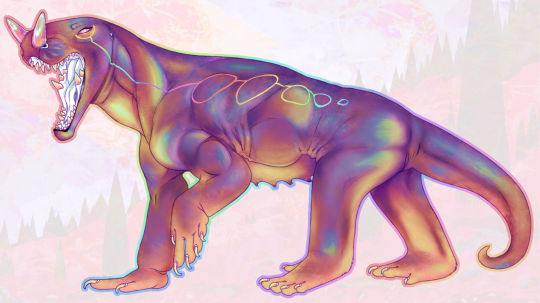
a long time ago youd have called her "mom" !
#gorgonopsid#paleoart#inostrancevia#pelycosaur#gorgonops#synapsid#stem mammal#mammal like reptile#adoptable#character design#rainbow
484 notes
·
View notes
Text
#Maysozoic Day 17 - Repenomamus
oh lord i have 8 days to catch up on rip, but yeah i dont draw synapsids (apart from humans) often so this took way longer than it shouldve

here's the prompt list:
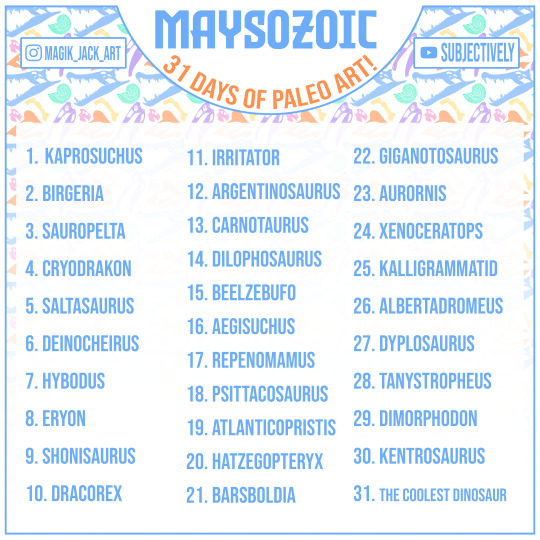
#Maysozoic#paleoart#paleontology#digital art#digital artwork#artists on tumblr#palaeoart#digital illustration#sciart#id in alt text#mammal#stem mammal
65 notes
·
View notes
Text

Happy pride yall. We have been here forever.
39 notes
·
View notes
Text


new PaleoArt, after so long, here's the triassic stem-mammal that became somewhat known because of WWD, Placerias! ------ nuevo PaleoArte, despues de tanto tiempo, aqui esta el proto-mamifero del triasico que se volvio algo conocido por Caminando Con Dinosaurios, Placerias! ---
#my art#paleoart#paleontology#triassic#paleoblr#dicynodont#placerias#stem mammal#synapsid#mesozoic#walking with dinosaurs
16 notes
·
View notes
Text
Being a zoologist will have you experiencing several brand new human interactions, such as people asking if you want a frog mummy, or sending professional emails to experts you respect to ask about their knowledge on identifying frog mummies.
#women in stem#shoutout to my roommate for asking with full sincerity if I wanted the frog mummy she found at work. Of course I do#Current theory is it died in torpor and got preserved by the freezing temperatures. Poor little dude#Anyway if any herpetologists on this website feel confident in their ability to ID a frog from skeletal remains alone hmu#I'm only really confident in mammal bone ID personally
5 notes
·
View notes
Text
#science#science communication#scicomm#stem#science education#science blog#biology#marine ecosystem#marine biology#marine mammals#marine life#lgbtqia#lgbt pride#lgbtq community#lgbtq
22 notes
·
View notes
Note
I personally call Dimetrodon and early synapsids like that "mammaloids" to differentiate them from the diapsid lineage (which I call reptiles for the sake of convenience). This linguistically makes sense to me because if humans are humanoid, then mammals are mammaloid.
Ooh I like that. I usually go with stem-mammals in most situations, but mammaloid is a great word
48 notes
·
View notes
Text

Therocephalians were a group of synapsids very closely related to – or possibly even ancestral to – the lineage leading to modern mammals. They were a diverse and successful group of carnivores during the latter half of the Permian, but suffered massively during the "Great Dying" mass extinction, with only a handful of representatives making it a few million years into the Triassic.
Tetracynodon darti was one of these rare Triassic therocephalian survivors, living in what is now South Africa around 251 million years ago. Only about 25cm long (~10"), it had slender limbs and strong claws that suggest it was a scratch-digger. Its long snout was lined with pointed teeth, and it was probably an active predator hunting by snapping its jaws at fast-moving prey like insects and smaller vertebrates.
Its combination of small size, burrow-digging habits, and unspecialized diet may be the reason it scraped through the Great Dying when most of its relatives didn't – but unfortunately it seems to have been a "dead clade walking", disappearing only a short way into early Triassic deposits.
———
NixIllustration.com | Tumblr | Patreon
References:
Fontanarrosa, Gabriela, et al. "The manus of Tetracynodon (Therapsida: Therocephalia) provides evidence for survival strategies following the Permo-Triassic extinction." Journal of Vertebrate Paleontology 38.4 (2018): 1-13. https://doi.org/10.1080/02724634.2018.1491404
Sigurdsen, Trond, et al. "Reassessment of the morphology and paleobiology of the therocephalian Tetracynodon darti (Therapsida), and the phylogenetic relationships of Baurioidea." Journal of Vertebrate Paleontology 32.5 (2012): 1113-1134. https://www.researchgate.net/publication/254315180_Reassessment_of_the_Morphology_and_Paleobiology_of_the_Therocephalian_Tetracynodon_Darti_Therapsida_And_The_Phylogenetic_Relationships_of_Baurioidea
Wikipedia contributors. “Tetracynodon” Wikipedia, 21 Aug. 2024, https://en.wikipedia.org/wiki/Tetracynodon
Wikipedia contributors. “Therocephalia” Wikipedia, 01 Oct. 2024, https://en.wikipedia.org/wiki/Therocephalia
#science illustration#paleoart#paleontology#palaeoblr#tetracynodon#lycideopidae#baurioidea#therocephalia#therapsid#synapsid#art#stem-mammal
265 notes
·
View notes
Text
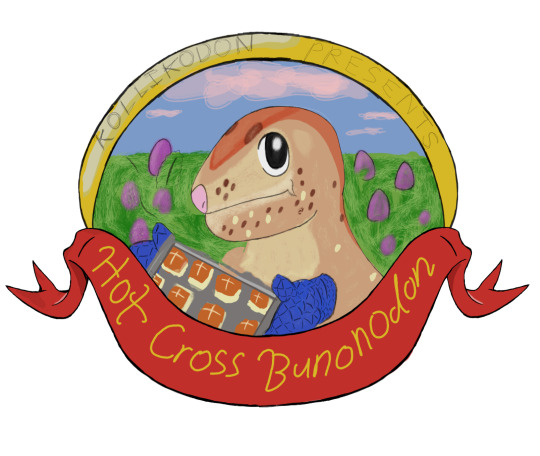
Kollikodon Presents: Hot Cross Bunodon WIP GAHHHH!! So close to Easter! I juuuuust missed it! Maybe I can make it presentable tomorrow? maybe...
#my art#paleoart#hot cross buns#WIP#easter#Kollikodon#stem monotreme#mammal#animal#chordata#chordate#paleoblr#bread rolls#hotcrossbunodon#bunodon#teeth#mesozoic#mesozoic mammals#bread#australian prehistory#lightning ridge#did she lay those eggs in the background? Whooooo knoooows???#prehistoric mammals#palaeontology#paleontology#digital art#eggs#easter egg
9 notes
·
View notes
Text
As bones encased in rock rotted away, water-borne silica seeped into the crevices, solidifying into opal and preserving precious details for 100 million years. The resulting fossils now provide evidence that there really may have been an Age of Monotremes, before other mammals came to dominate. "It's like discovering a whole new civilization," says Australian Museum paleontologist Tim Flannery. "Today, Australia is known as a land of marsupials, but discovering these new fossils is the first indication that Australia was previously home to a diversity of monotremes." Only five of these rare mammals still cling to existence: one platypus and four echidna species, shared between Australia and Papua New Guinea. But due to their reptilian-like egg-laying feature, it has long been thought these animals evolved before placental mammals like us and marsupials.
Continue Reading.
116 notes
·
View notes
Text
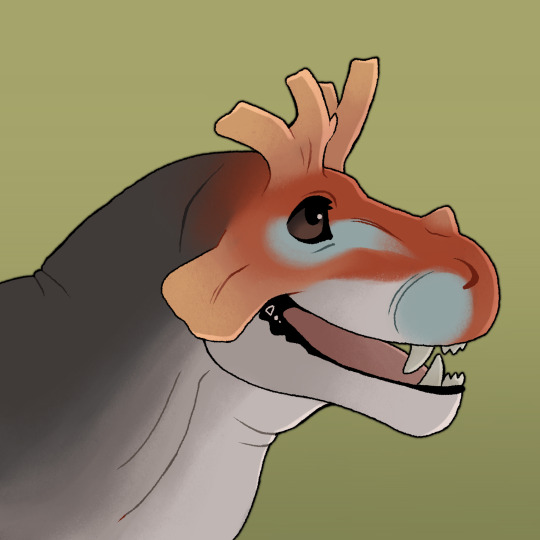
I’m trying to get back into drawing paleo art. Here’s a happy estemmenosuchus
#my art#estemmenosuchus#paleoart#paleontology#paleobr#permian#synapsids#therapsid#stem mammals#digital aritst
31 notes
·
View notes
Text
also dimetrodon is closer related to you and me than it is to dinosaurs
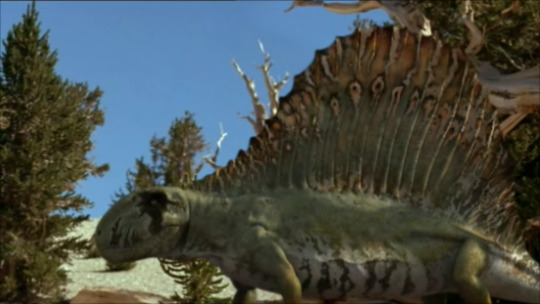
this is your evolutionary weird aunt put respect on her name
#/thats a big joke btw#since its (as far as im aware) a pelycosaur and not directly related to the line mammals stem from#however much like the therapsids (which we are technically a part of) theyre synapsids so#im seeing this as reason enough for the joke#however the first bit is true#due to being a synapsid and not a sauropsid its cliser related to you and me than dinosaurs
16 notes
·
View notes